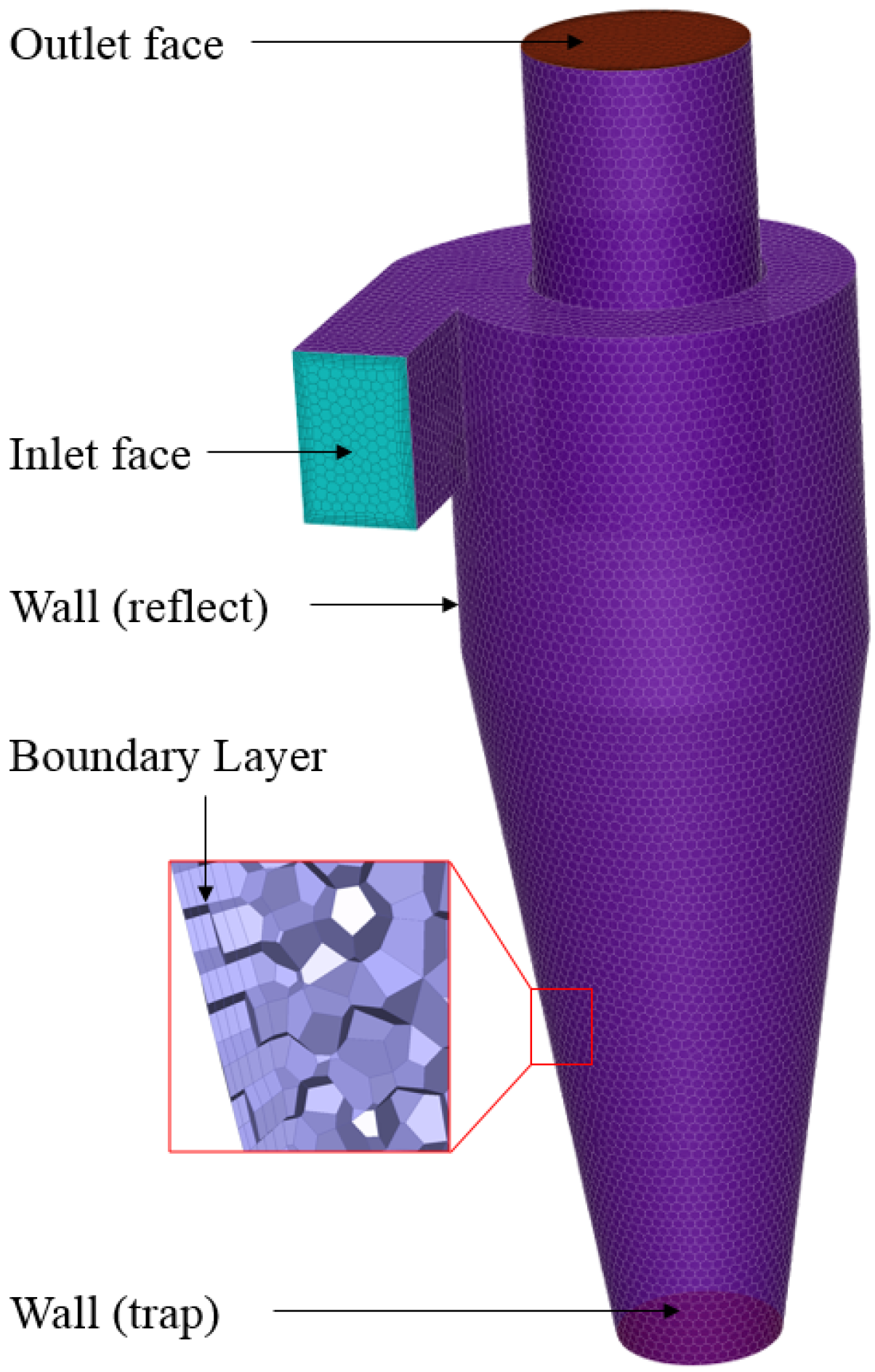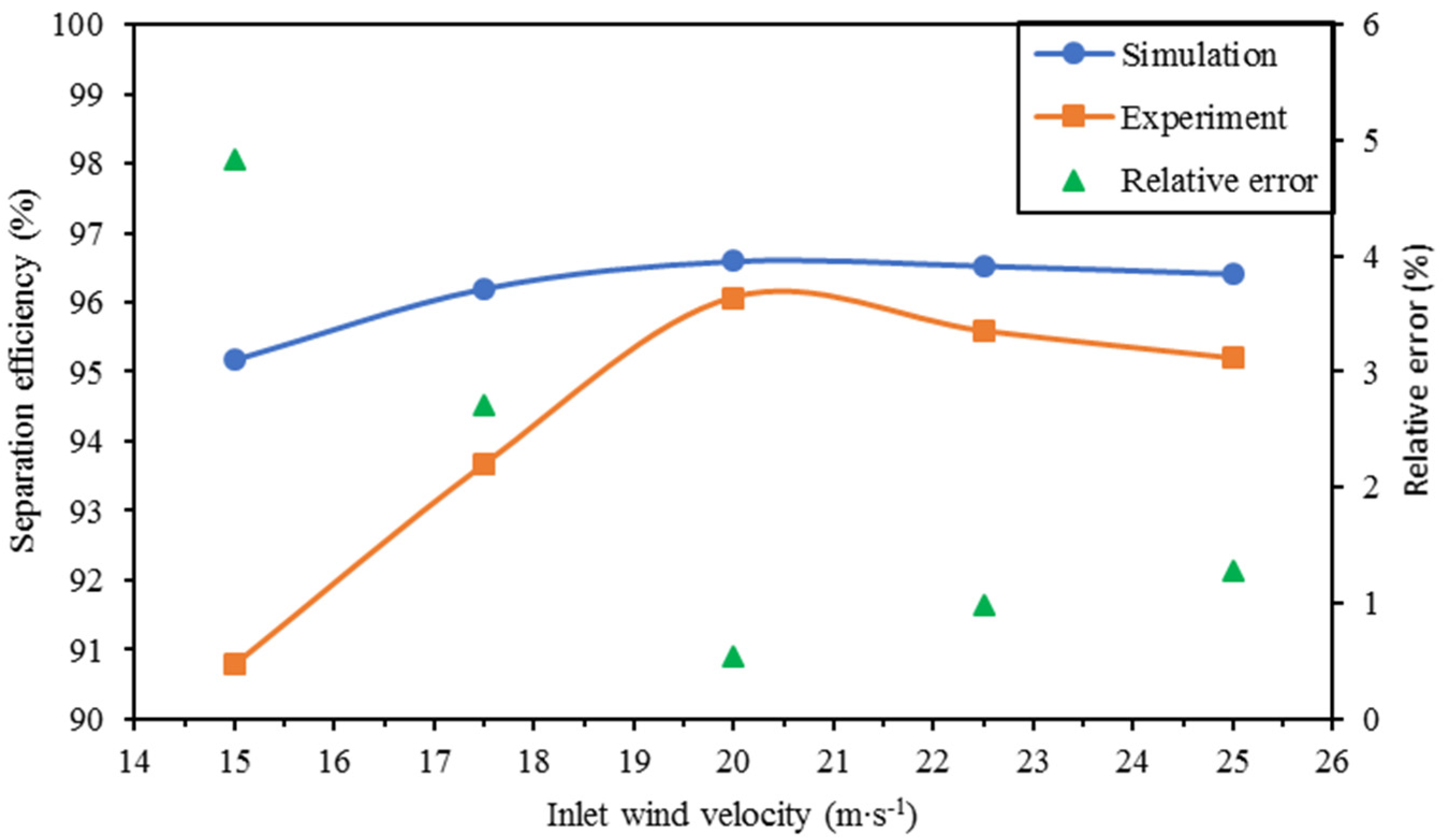Numerical Simulation and Experiment of Dust Suppression Device of Peanut Whole-Feed Combine Using Computational Fluid Dynamics
Abstract
:1. Introduction
2. Materials and Methods
2.1. Description of Dust Suppression Device for the Peanut Whole-Feed Combine
2.2. CFD Analysis
2.2.1. Mathematical Model
2.2.2. Model and Boundary Conditions
2.2.3. Discrete Phase Model
2.2.4. Solution Methods and Simulation Procedure
2.3. Model Validation Test
2.3.1. Dust Suppression Test System
2.3.2. Measurement of Separation Efficiency and Particle Size
2.3.3. Experiment Condition
3. Results
3.1. Analysis of Simulation Results
3.2. Analysis of Separation Efficiency
3.3. Analysis of Particle Size Distribution
4. Conclusions
Author Contributions
Funding
Institutional Review Board Statement
Informed Consent Statement
Data Availability Statement
Acknowledgments
Conflicts of Interest
References
- Chen, Z.; Gao, L.; Chen, C.; Butts, C.L. Analysis on technology status and development of peanut harvest mechanization of China and the United States. Trans. Chin. Soc. Agric. Mach. 2017, 48, 1–21. [Google Scholar]
- Zhang, P.; Xu, H.; Zhuo, X.; Hu, Z.; Lian, C.; Wang, B. Biotribological characteristic of peanut harvesting impact-friction contact under different conditions. Agronomy 2022, 12, 1256. [Google Scholar] [CrossRef]
- Yang, H.; Cao, M.; Wang, B.; Hu, Z.; Xu, H.; Wang, S.; Yu, Z. Design and test of a tangential-axial flow picking device for peanut combine harvesting. Agriculture 2022, 12, 179. [Google Scholar] [CrossRef]
- Zhang, P.; Xu, H.; Hu, Z.; Chen, Y.; Cao, M.; Yu, Z.; Mao, E. Characteristics of Agricultural Dust Emissions from Harvesting Operations: Case Study of a Whole-Feed Peanut Combine. Agriculture 2021, 11, 1068. [Google Scholar] [CrossRef]
- Chen, W.; Tong, D.Q.; Zhang, S.; Zhang, X.; Zhao, H. Local PM10 and PM2. 5 emission inventories from agricultural tillage and harvest in northeastern China. J. Environ. Sci. 2017, 57, 15–23. [Google Scholar] [CrossRef] [PubMed]
- Schenker, M. Exposures and Health Effects from Inorganic Agricultural Dusts. Environ. Health Perspect. 2000, 108, 661–664. [Google Scholar]
- Zhou, L.; Chen, X.; Tian, X. The impact of fine particulate matter (PM2. 5) on China’s agricultural production from 2001 to 2010. J. Clean. Prod. 2018, 178, 133–141. [Google Scholar] [CrossRef]
- Xu, H.; Zhang, P.; Hu, Z.; Mao, E.; Yan, J.; Yang, H. Analysis of dust diffusion from a self-propelled peanut combine using computational fluid dynamics. Biosyst. Eng. 2022, 215, 104–114. [Google Scholar] [CrossRef]
- Baticados, E.; Capareda, S.; Maglinao, A. Particulate matter emission factors using low-dust harvesters for almond nut-picking operations. J. Air Waste Manag. Assoc. 2019, 69, 1304–1311. [Google Scholar] [CrossRef]
- Guofeng, W.; Yuanjuan, G.; Dezhi, R.; Zhao, J.; Xuewei, B. Research on dust control of mobile straw granulator. Comput. Electron. Agric. 2021, 189, 106375. [Google Scholar] [CrossRef]
- Kruckman, H.D. Combine dust eliminator. U.S. Patent US6036600 A, 14 March 2000. [Google Scholar]
- Law, S.E.; Giles, D.K. Electrostatic abatement of airborne respirable dust emission from mechanized tree-nut harvesting: Theoretical basis. J. Electrost. 2009, 67, 84–88. [Google Scholar] [CrossRef]
- Yang, M. A Dust Removal Device for Agricultural Machinery. CN2018203303457, 16 April 2019. [Google Scholar]
- Liu, Y.; Shao, L.; Wang, W.; Chen, J.; Zhang, H.; Yang, Y.; Hu, B. Study on Fugitive Dust Control Technologies of Agricultural Harvesting Machinery. Agriculture 2022, 12, 1038. [Google Scholar] [CrossRef]
- Cai, J.; Wang, Z.; Jin, Y.; Lyu, J.; Yang, H. Analysis of Gas-solid Flow Distribution in Double Identical Parallel Cyclones. Proc. CSEE 2019, 39, 2106–2113. [Google Scholar]
- Wang, P.; Tan, X.; Zhang, L.; Li, Y.; Liu, R. Influence of particle diameter on the wettability of coal dust and the dust suppression efficiency via spraying. Process Saf. Environ. Prot. 2019, 132, 189–199. [Google Scholar] [CrossRef]
- Li, S.; Zhao, B.; Lin, H.; Shuang, H.; Kong, X.; Yang, E. Review and prospects of surfactant-enhanced spray dust suppression: Mechanisms and effectiveness. Process Saf. Environ. Prot. 2021, 154, 410–424. [Google Scholar] [CrossRef]
- Zhou, Q.; Qin, B. Coal dust suppression based on water mediums: A review of technologies and influencing factors. Fuel 2021, 302, 121196. [Google Scholar] [CrossRef]
- Cortés, C.; Gil, A. Modeling the gas and particle flow inside cyclone separators. Prog. Energy Combust. Sci. 2007, 33, 409–452. [Google Scholar] [CrossRef]
- Gawali, S.S.; Bhambere, M.B. Effect of design and the operating parameters on the performance of cyclone separator-a review. Int. J. Mech. Eng. Rob. Res. 2015, 4, 244–248. [Google Scholar]
- Durbin, P. A Reynolds stress model for near-wall turbulence. J. Fluid Mech. 1993, 249, 465–498. [Google Scholar] [CrossRef]
- Wallin, S.; Johansson, A. An explicit algebraic Reynolds stress model for incompressible and compressible turbulent flows. J. Fluid Mech. 2000, 403, 89–132. [Google Scholar] [CrossRef]
- Feng, Y.Q.; Yu, A.B. Assessment of Model Formulations in the Discrete Particle Simulation of Gas–Solid Flow. Ind. Eng. Chem. Res. 2004, 43, 8378–8390. [Google Scholar] [CrossRef]
- Wang, B.; Xu, D.L.; Chu, K.W.; Yu, A.B. Numerical study of gas–solid flow in a cyclone separator. Appl. Math. Model. 2006, 30, 1326–1342. [Google Scholar] [CrossRef] [Green Version]
- GBZ/T 192.1; Determination of Dust in the Air of Workplace. Part 1: Total Dust Concentration. Standardization Administration of the People’s Republic of China: Beijing, China, 2007.
- Elsayed, K.; Lacor, C. Optimization of the cyclone separator geometry for minimum pressure drop using mathematical models and CFD simulations. Chem. Eng. Sci. 2010, 65, 6048–6058. [Google Scholar] [CrossRef]
- González-Tello, P.; Camacho, F.; Vicaria, J.M.; González, P.A. A modified Nukiyama–Tanasawa distribution function and a Rosin–Rammler model for the particle-size-distribution analysis. Powder Technol. 2008, 186, 278–281. [Google Scholar] [CrossRef]
- Wan, G.; Sun, G.; Xue, X.; Shi, M. Solids concentration simulation of different size particles in a cyclone separator. Powder Technol. 2008, 183, 94–104. [Google Scholar] [CrossRef]
- Xu, H.; Zhang, P.; Hu, Z.; Mao, E.; You, Z.; Du, Y. Analysis of dust emission characteristics of peanut whole-feed harvesting based on total amount collection method. Int. J. Environ. Res. Public Health 2022, 19, 15937. [Google Scholar] [CrossRef]
- Qian, J.; Ferro, A.R.; Fowler, K.R. Estimating the resuspension rate and residence time of indoor particles. J. Air Waste Manag. Assoc. 2012, 58, 502–516. [Google Scholar] [CrossRef]
- Stacey, P.; Thorpe, A.; Roberts, P.; Butler, O. Determination of respirable-sized crystalline silica in different ambient environments in the United Kingdom with a mobile high flow rate sampler utilising porous foams to achieve the required particle size selection. Atmos. Environ. 2018, 182, 51–57. [Google Scholar] [CrossRef]








| Index | Symbol | Value |
|---|---|---|
| Diameter of cylinder (mm) | D | 700 |
| Height of cylinder (mm) | H | 1950 |
| Height of cone (mm) | Hc | 1300 |
| Depth of exhaust pipe (mm) | S | 400 |
| Height of intake pipe (mm) | a | 300 |
| Width of intake pipe (mm) | b | 200 |
| Diameter of exhaust pipe (mm) | de | 400 |
| Diameter of dust collection bucket (mm) | db | 200 |
| Dust Group | Property | Value | Sources |
|---|---|---|---|
| Total flow rate of dust (mg∙s−1) | 9513.7 | Calculated by Equation (7) | |
| Temperature (K) | 300 | Measured by temperature sensor | |
| Ture density of dust (g∙cm−3) | 2.5277 | Measured by automatic true density analyzer | |
| 1 | Flow rate of dust (mg∙s−1) | 2179.6 | Calculated by Ref. [8] |
| Min. diameter of dust (μm) | 1 | Measured by laser particle size analyzer | |
| Max. diameter of dust (μm) | 10 | Measured by laser particle size analyzer | |
| Size constant of dust (μm) | 7.3 | Estimated by Rosin–Rammler curve fit | |
| Spread parameter of dust | 2.76 | Calculated by Ref. [8] | |
| 2 | Flow rate of dust (mg∙s−1) | 7334.1 | Calculated by Ref. [8] |
| Min. diameter of dust (μm) | 11 | Measured by laser particle size analyzer | |
| Max. diameter of dust (μm) | 310 | Measured by laser particle size analyzer | |
| Size constant of dust (μm) | 27.5 | Estimated by Rosin–Rammler curve fit | |
| Spread parameter of dust | 1.35 | Calculated by Ref. [8] |
| Test No. | Engine Speed/rpm | Wind Velocity/(m∙s−1) | Peanut Plants Weight/kg |
|---|---|---|---|
| T1 | 1500 | 15.0 | 250 |
| T2 | 1750 | 17.5 | 250 |
| T3 | 2000 | 20.0 | 250 |
| T4 | 2250 | 22.5 | 250 |
| T5 | 2500 | 25.0 | 250 |
Disclaimer/Publisher’s Note: The statements, opinions and data contained in all publications are solely those of the individual author(s) and contributor(s) and not of MDPI and/or the editor(s). MDPI and/or the editor(s) disclaim responsibility for any injury to people or property resulting from any ideas, methods, instructions or products referred to in the content. |
© 2023 by the authors. Licensee MDPI, Basel, Switzerland. This article is an open access article distributed under the terms and conditions of the Creative Commons Attribution (CC BY) license (https://creativecommons.org/licenses/by/4.0/).
Share and Cite
Xu, H.; Zhang, P.; Gu, F.; Hu, Z.; Yang, H.; Mao, E.; Du, Y. Numerical Simulation and Experiment of Dust Suppression Device of Peanut Whole-Feed Combine Using Computational Fluid Dynamics. Agriculture 2023, 13, 329. https://doi.org/10.3390/agriculture13020329
Xu H, Zhang P, Gu F, Hu Z, Yang H, Mao E, Du Y. Numerical Simulation and Experiment of Dust Suppression Device of Peanut Whole-Feed Combine Using Computational Fluid Dynamics. Agriculture. 2023; 13(2):329. https://doi.org/10.3390/agriculture13020329
Chicago/Turabian StyleXu, Hongbo, Peng Zhang, Fengwei Gu, Zhichao Hu, Hongguang Yang, Enrong Mao, and Yuefeng Du. 2023. "Numerical Simulation and Experiment of Dust Suppression Device of Peanut Whole-Feed Combine Using Computational Fluid Dynamics" Agriculture 13, no. 2: 329. https://doi.org/10.3390/agriculture13020329







